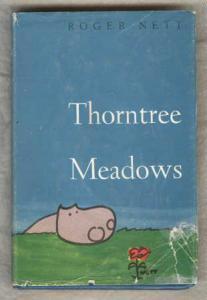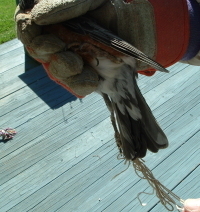Marian Allen's Blog, page 438
April 20, 2012
R is for Robert L. Iles

Photo by Patty Foster
Robert L. Iles passed away in 2007, and his wife, the lovely Phyllis, in 2010. I only met the two of them once, when Bob came to do a book signing in Corydon, but I corresponded with him by email. He was one swell guy, and funnier than hell. I miss him every day.
I interviewed him once, for an online magazine which also is no more. I reprint it today in Remembrance of him.
The Burning Woman is Robert L. Iles’ second book published
by Avid Press in ten months. After many years in medical
writing, he says switching to fiction is “a blast. It’s like
getting out of a limo and hopping in a Corvette and flooring
it.” He lives and works in Olathe, Kansas.
MA: You have a new book of short stories just out from Avid
Press (ordering information linked at end of article). Tell
us something about it: Over what period of time did you
write these stories? What inspired you to write them? Have
any of them been published before? If so, where?
ILES: I wrote the first story in the Peter B. Bruck, Private
Investigator series, “The Missing Sister Caper,” in 1995,
and it was published in the 1996 winter issue of Red Herring
Mystery Magazine. Twelve more stories followed in rapid
succession, so that by 1999 I had 13 in print. When my
publisher wanted to collect them in a book, I decided to cap
them with a short Bruck novel, “The End of It,” which I
wrote in early 2000.
The 13 short stories appeared in Murderous Intent,
Whispering Willows, Blue Murder, The Thrilling New
Detective, Cozy Detective, Potpourri, and Sleuthhound
magazines before coming out as a collection. “The End of It”
has never been in print before.
My inspiration for the stories was the private-eye stories
I’ve enjoyed reading over the years, and the film noir
movies with private detective leads like Bogart, Mitchum,
Powell, and, believe it or not, Jack Carson and Bob Hope.
Other than a believable plot that keeps me guessing, the
thing I like most in a story is humor. When I wrote the
laugh lines in the Bruck stories, I realized I could just
about hear Jack Carson or Bob Hope saying them.
MA: Bruck stories aren’t all you write, are they?
ILES: I also write about a fictional rural sheriff’s
department staffed by the former sheriff and his son, who
feels that being deputy is just a temporary spot from which
he will spring into the sheriff’s job, now occupied by Okie
Bliss, who served as undersheriff for 20 years. DEAD WRONG
told the story of their pursuit of a suspect in the death of
a beautiful young girl. THE MOTEL MURDERS, soon to be the
second in the series, centers on deaths at a ma-and-pa motel
way off the beaten path.
When the cupboard is bare, I return to medical writing,
where I made my living before turning to crime writing.
Generally, it consists of ghostwriting journal articles,
book chapters and monographs for physicians and researchers.
I also do medical writing under my own name, so you’ll see
me listed as an author here and there. And my GUIDEBOOK TO
BETTER MEDICAL WRITING, “the how-to book for writing journal
articles,” is selling well not only in the U. S. but in
Europe, Asia and Australia.
I credit a friend in Japan for getting me to write it,
translating it into Japanese, and getting it published in
Japan. Takeo Hikichi is a professor of English at the
Fukushima Medical College in Fukushima City. I’m the
publisher of the English-language version. (Please, no smart
questions about who translated my U. S. version into
English.)
MA: Any plans to blend your medical expertise and your crime
writing?
ILES: Not any plans, but a writer uses what he has. I’ve
found that in some of my stories I present information that
I wouldn’t if I had no background in medicine. For example,
Doc Young is a character in DEAD WRONG and in the book I’m
working on now, so I have him doling out bits and pieces of
medicine that are integral to the plots. And in THE BURNING
WOMAN I used some of what I’ve learned about medicine.
My so-called medical background is just a crazy-quilt of
bits and pieces. I could do what I’ve done in medical
science for another 100 years and still not be half a
doctor. Of course, I tell all the women in my neighborhood
practice…… Well, I won’t go into that.
MA: You’ve told us about your Hollywood inspirations; how
about your literary inspirations? Hammett? Chandler? Stout?
Spillane? Any others? Any surprises?
ILES: I think any mystery writer would like to say Hammett,
Chandler, Stout, Spillane et al are his inspiration. But I’m
not ready to claim any connection with them. (Well, if you
insist….)
The writers whose work appeared so simple that I thought,
Gee, I oughta be able to do that are Maurice Proctor,
Jonathan Ross, Reginald Hill, Michael Gilbert, Colin Dexter,
James McClure, Georges Simenon and Matsumoto. Surprise. It
isn’t simple.
If I ran the literary world, I’d see to it those guys were
ranked up there with the authors who produce serious novels
of relationships, passages, angst, societal insights and
other dreary stuff. I would like a literature professor
to tell me why Hill, Dexter and McClure, for example, can’t
be honored as literary masters instead of just as mystery
writers.
MA: What’s the hardest part of writing a mystery? Concocting
clues? Hiding the clues? What do you think about the “play
fair with the reader” stance? Did Agatha Christie, for
example, “play fair”? Do you?
ILES: For me the hardest parts of writing a mystery are
figuring out who did it and why. That’s because I invent the
murder at the outset and go on to invent the characters.
Subsequently I let the characters develop; actions and plot
points grow out of their development. It’s the hard way of
doing things but also the most fun, and maybe the best way
to build a mystery the reader both believes and enjoys.
Yes, clues must be hidden along the way, and in plain sight.
They might be an expected part of a character’s behavior so
they aren’t seen as clues, or they may be ambiguous. But
keeping from the reader until the very end that Colonel
Mustard had a hollow leg in which he kept an apparatus that
transmitted TV pictures of everything that went on in the
library to the back of his eyeglass frames…well, that’s
not cricket, or even baseball.
I’d like to be able to hide clues as well as Agatha Christie
did. Rex Stout was pretty good at it, too. And Ed Dee, who
writes New York cop stories, ranks pretty high. But enough
about the acknowledged craftsmen. (Craftsmen and
craftswomen? Craftspersons? Crafty writers? As William
Safire said, “Person the lifeboats, the language is going
down!”) Me, I try to play fair with the reader. I’d love to
hear from anyone who thinks my clues aren’t fair. I can’t
make a money-back offer, but if complainers are nasty
enough, I will put them in my next book as the cranky Miz
Kerridge or the grouchy ol’ Payne. Step right up, don’t be
bashful.
MA: That brings up another question: Do you ever write real
people into your books, as tribute, as revenge, or just for
fun? If you wreak revenge on a real person through your
fiction, what do you do to protect yourself from their wrath
or, worse yet, their lawyers?
ILES: When I go back through my casts of characters, I have
to admit a few are close to 100 percent from real life. But
I only do that with people who can’t read. (See how neat I
did that? None of my old pals is gonna jump up and claim he
is the model for some knucklehead who can’t read.)
Probably no writer makes a character up out of whole cloth.
His observance of human behavior is going to determine how
he paints his fictive people. And I know that in my case I
sometimes devise characters whom I at first don’t think are
modeled on someone, but later realize, “Gee, there’s a big
slice of ol’ Juice in the con man. He came up out of my
subconscious and got on paper without me knowing it. He
really is a sneaky guy.”
MA: DEAD WRONG seems to have a more somber tone than the
Bruck stories. Are you trying to “do more” with that series,
or is it a matter of length–do you feel you can go more
into depth and motivation, create more reality, in a longer
work?
ILES: I think I was just writing two different books, and
the accident of mood (“Gawd, I feel mean today. Think I’ll
write a book about mean people.”) might have had something
to do with the mood or tone of DEAD WRONG.
There is no doubt, though, that the Bruck stories are my
idea of fun. I doubt I could write a somber Bruck story.
Somehow at the outset I saw Bruck as a guy who likes a
laugh–even at his own expense, even when danger is
direst–and that’s the groove I’ve stayed in.
Practicing a little psychiatry without a license, I’ll tell
you I have, in the trendy phrase of the day, some “unresolved
issues from my childhood” in the town where I grew up, which
is the inspiration for Mt. Hope in DEAD WRONG. If I ever get
to the William Faulkner level in literature–may take a
week or two–it will be fun to see what the amateur
psychologists (more commonly known as literary critics) have
to say about me. “Hmm, deep-seated anxieties that someone
was going to steal his bicycle are clearly reflected in the
scene where the sheriff beats the bejesus out of the dead
girl’s stepfather.” Wow, I get to be a writer and get free
analysis of my id, ego, and super-ego plus free drinks at
book signings. When do the girls get here?
MA: You’re both a short-story writer and a novelist. Are the
two similar? Can a writer who does one do the other?
ILES: I don’t think mystery writers see them as similar. A
short mystery story is a little like a watch. The pieces fit
each other precisely, without gaps. There are no pieces
plugged in from other “watches” (stories) that didn’t
work right. And most notably, there are no extra pieces.
In a mystery novel, you can have extra pieces–characters
who are interesting but who don’t do much to further the
plot and scenes that illuminate a character’s mind but do
little to make the plot work. And if the main character’s
bartender comes from another book you never completed,
well, as long as he’s interesting and doesn’t get in the
way, that’s okay.
Can a writer who does one do the other? I don’t know. There
is a long list of writers who have done both well, but who
knows how many have tried to jump from one form to the other
and have fallen on their face. (You English teachers out
there may now pause to debate whether that should be “face”
or “faces.” That’s one of the great things about
first-person detective and cop fiction: No one expects them
to talk right. And while I’m on the subject, I know English
grammar better than the average bear, and the hogwash I have
heard at writers’ conferences and in writing courses….
Well, let’s just say you’re better off teaching yourself to
write, with a college grammar book at the ready.)
MA: What kind of research did you do for your books? I’m
particularly thinking of the Bruck stories/novel, with the
period details and atmosphere. You didn’t crib all of that
out of old movies.
ILES: I lived in Jersey for a year and half, close enough to
Manhattan you could see the Empire State Building from my
bedroom, and from time to time my work would take me to the
city. And there are times now that I live back in the good
old midwest that my work takes me there.
But the number of visits and the amount of time I spend
there don’t matter as much as the fact that the place
fascinates me. I’m still Leonard Hick from Punkin Crick.
“Gorsh, looka all them tall buildings. Golly, where do all
these people come from and where are they going?”
I do not have a New Yorker’s love for the place, but I like
being there, feeling the hustle-bustle, the mysteries of a
place that could be called the capital of the world. So I
pay attention to it. I’d ten times rather read a mystery set
there than in LA or Dallas or Corydon. (I made that up;
there is no Corydon.) [Interviewer's note: The interviewer
is from Corydon.]
Finally, the real truth: When you’re a fiction writer, you
can claim Broadway crosses Second Avenue and most readers
either won’t know or won’t bother to care about it. Those
that do will publicize your book with their rants about
inaccuracies.
I especially enjoy making up “truth” in psychiatry when I’m
writing fiction. Anything you say about the field or the
practitioners has been or will be true. A Park Avenue shrink
who treats psychoses by spraying patients with horse dung? Uh,
sure, I suppose it’s happened, or will.
MA: One final question: Your Bruck book is a print-on-demand
publication. What does this technology mean to authors?
ILES: As I see it, only good. The production values–cover
color, quality of cover and inside paper, price, readability
of print–are the same or better. So to readers, everything
is fine.
To book distributors and bookstores, everything is probably
better than fine. They don’t have to carry large stocks of
books that take up expensive space and that cost an arm and
a leg to ship. “Shipping” is done pretty much
electronically. Just think how quickly the online
booksellers will take unto their bosom the idea of printing
on demand. Well, yeah, Amazon is actually a word meaning
without a breast, but….
“Ah,” you say, “but will Mr or Miz (I hate that so-called
word, and women should, too. It sounds like short for
‘miserable’) Ordinary Book Buyer want to wait for a
book–won’t they just buy one that’s on the shelf and be on
their way?” Ah, I say, it ain’t the way you paint it.
First, print-on-demand books can now be shipped to the
retail stores in a matter of days from a warehouse that
prints books on demand. We wait that long now for the books
we order.
Second, the day is coming when the books will be printed at
the bookstore in about 15 minutes. It’ll be like ordering a
decaff latte, whipped cream, no cinnamon. Large. In a
go-cup.
Third, unless you are a blockbuster author, the chances of
your book being on every store’s shelves all the time are
nil. But with POD, books by new authors and from small
publishers as well as books by big-time authors and from
huge publishers will be “on” most stores’ shelves “all” the
time, in the sense that the books can be printed and a
quality cover can be glued on in about 15 minutes.
Fourth, small publishers and new authors probably will have
a better chance of reaching their particular readers. Right
now, only big publishers are making respectable profits, and
their operations are so expensive they don’t want to gear up
for Jack Nobody’s book about insect fossils at the South
Pole. Small publishers who do POD can afford to publish
books like that.
Fifth, forget everything I said for a couple of years. If it
turns out I was right–that POD books have a significant
(10-30%) and growing fraction of the market–erect a statue
to me, bow down and send money. If it turns out I was wrong,
well, it’s the fault of all the people who don’t like me
and gummed up the works on purpose.
MA: Whether or not one likes Mr. Iles (and the interviewer
confesses that one does like him, in spite of his attitude
toward the chattel-neutral term, “Ms.”, which was standard
business usage long before the ’60′s backlash demonized it)
–whether or not, the interviewer repeats, one likes Robert
Iles, one has to admit he spins one hell of a yarn.
Bob’s books are still available at Amazon.com.
If Bob were around today, he would love it if I signed this:
Yours truly,
O. ReVuar
A WRITING PROMPT FOR YOU: Interview a friend.
MA

April 19, 2012
Q is for Quatro
 Quatro Petrie is one of the characters in FORCE OF HABIT. Imma interview him. But first, a description:
Quatro Petrie is one of the characters in FORCE OF HABIT. Imma interview him. But first, a description:
Black fuzz covered Quatro’s skull, like the plush on a cheap toy. Now, as usual, so did a wig. His long, thin fingers and toes had vestigial webs to the first joint. He was tall and thin, like a walking test tube.
MA: You’re not a Terran, are you? Or, as some people say, an Earthling?
QP: No. My sister, Tetra, and I are Gilhoolies. That is, we’re from the planet Gilhoo. My sister and I are both fluent in Allesesperanto and … frankly, too many languages to list.
MA: I need to inform my readers that Gilhoo is a water planet.
QP: Indeed. Why else would I have these gills?
MA: Possibly because you’re all wet.
QP: I beg your pardon?
MA: That’s all right. So how did you come to be teaching on a spaceship?
QP: I applied and was accepted. But perhaps you wonder why I applied.
MA: Yes. Yes, I do.
QP: My sister said that she intended to do so. I consider her somewhat madcap, I regret to admit, and thought it might be best if accompanied her. As it happened, it was well that I did. My sobering and clarifying presence has proved invaluable aboardship on more than one occasion.
MA: Zzzzzzzzzzz– Oh! Uh, yes. Yes. Well, thank you for visiting with us today, Quatro. Uh, farewell, and … um … just keep swimming.
A WRITING PROMPT FOR YOU: Interview an extra-terrestrial.
MA

April 18, 2012
P is for Plonk
Horace Rumpole, aka Rumpole of the Bailey, in case you don’t know, frequents Pommeroy’s Wine Bar, a “wine bar” supposedly being a bar that only serves wine, though Pommeroy’s seems to serve sandwiches and mixed drinks, as well.
Rumpole usually buys a glass or a bottle of what he calls Pommeroy’s Plonk. “Plonk” is a word of Australian origin, now common in Great Britain. During World War I, UK soldiers stationed in France came into contact with white wine (in French, vin blanc). This was transformed into ving blong, vin blank, von blink, point blank and plinketty plonk. By 1933, the term plonk was common enough to be used in court. Also by that time, it meant or implied bad or cheap wine of any color or from any source. These days, it usually refers to cheap red wine, a far cry from the (probably) delicious French white wine which inspired the word.
The only red wine I can drink these days is Chianti. For some reason, Chianti doesn’t give me the immediate and punishing headache other red wines do, even if the other red wines are expensive and the Chianti is a dollar a gallon. Is it a contradiction in terms to be have a discriminating palate in plonks?
A WRITING PROMPT FOR YOU: A character is in a quality restaurant when someone orders a glass of plinketty plonk. How does the character react, feel, think, behave, speak? The character could be with the person ordering, at a different table, passing, or could be part of the restaurant staff.
MA

April 17, 2012
O is for Orchid
From The Free Dictionary:
1.
a. A member of the orchid family.
b. The flower of any of these plants, especially one cultivated for ornament.
2. A pale to light purple, from grayish to purplish pink to strong reddish purple.
From our #2 daughter’s kitchen:

Nero Wolfe, one of Mom and my (yes, that is grammatically correct) favorite detectives, grows orchids in his rooftop greenhouse in NYC.
They smell good. The orchids, not the detectives.
I’m posting today at Fatal Foodies on the subject of Ovens.
A WRITING PROMPT FOR YOU: Write about something purple.
MA

April 16, 2012
N is for Noomo by Nett

Noomo, the cover boy
I’m a kiddie lit junkie. I say it proudly. My library contains many of Lang’s Rainbow Fairy Tales books, AB THE CAVE BOY, as many of Terhune’s collie books as I can find, SOUTH SEA ADVENTURES, as many Freddie the Pig books as I can lay hands on, FIVE BOYS IN A CAVE, and Roger Nett’s THORNTREE MEADOWS.
THORNTREE MEADOWS was first published in 1957. I don’t know when I first read it, or when I lost it, but it was only a few years ago that my mother, through the power of the internet, surprised me by buying me a copy. I was afraid to re-read it, afraid it wouldn’t be as good as I remembered. I’m happy to report that it was. 
Now, Kirkus gave it a bad review, which only means that the Kirkus reviewer is not seriously twisted. That could be a good thing, or a bad thing, depending on one’s attitude toward serious twistiosity.
Noomo, the lead character in THORNTREE MEADOWS, is a hippopotamus who shares a bucolic area in what appears to be England? America? some temperate zone, at any rate, with an aardvark, a pig named Hamlet, and a living stuffed dog named Orlon. There is no explanation given of why these animals are in this place, or how a dog that is a toy dog with a tag sewn into his ear (that’s how they know his name is Orlon) is alive. The story doesn’t break stride when the aardvark’s den is flooded and they use Orlon to mop it out. He doesn’t mind.
Then there’s the time the ants kidnap the aardvark and hold him for ransom until he promises not to eat them anymore.
Noomo is a rather philosophical hippopotamus, though not quite the “uncarved block” that is Pooh.
THORNTREE MEADOWS makes me happy. And that’s a good thing.
A WRITING PROMPT FOR YOU: What was your character’s favorite story when he or she was little?
MA

April 12, 2012
K is for Kosair
If the word "Kosair" is new to you, you aren't from around here. Kosair Children's Hospital is a magical mantra that brings reassurance and hope to anyone in the Kentuckiana area who loves or has loved a sick child.
 When I was a kid, there was an epidemic of polio (poliomyelitis) — a viral infection that causes paralysis in up to 2% of cases. Most people who get the virus don't even know they've had it. Apparently, I was one of those. The daughter of a friend of my mother's wasn't so lucky. I remember going to Kosair to visit the child in an iron lung. Imagine seeing the little curl-topped head of your friend sticking out of one of these.
When I was a kid, there was an epidemic of polio (poliomyelitis) — a viral infection that causes paralysis in up to 2% of cases. Most people who get the virus don't even know they've had it. Apparently, I was one of those. The daughter of a friend of my mother's wasn't so lucky. I remember going to Kosair to visit the child in an iron lung. Imagine seeing the little curl-topped head of your friend sticking out of one of these.
Polio was everywhere. We were all terrified of it. The only thing that gave us any sense of safety was Kosair. They not only had the best pediatric specialists, they were famous for treating their patients as people. As child people. As people who mattered.
Here's a site about the American polio epidemics. Please click through and read the intense and beautiful poem about air.
Even today, when polio and iron lungs are pretty much things of the past, any news of an ill or injured child that's followed by the words, "They took him to Kosair," causes everyone who hears it to breathe a little easier.
Kosair is still there, with multiple locations and increasing outreach, active not just in hospitalization and treatment but also in health and safety education and child advocacy. Here's a link to their Ways To Help page, with links to their free magazine on child health and safety, Cartwheels. Please click through and see what they offer for any child anywhere and what you can do to help.
WRITING PROMPT: A character is apparently immune to an epidemic that is raging around him or her.
MA

April 11, 2012
J is for Junior Mints, Vegan, My Way
My mother loves Junior Mints, but her cardiologist tells her not to eat chocolate, so she's given up that treat. One year, our #3 daughter gave her a box of pastel ones, coated in pastel candy (white "chocolate", maybe?), but that seems to have been a one-off, and I couldn't find any last year or this year.
So I went internettin' and found this DIY recipe.
I found, as I got started, that I did NOT have any peppermint extract! I do have mint in the back(space)yard, so I picked some and simmered it in a bit of water and used some of that water in the recipe. It wasn't strong enough, I'll tell you that right now. The filling turned out yummy, but not very minty.
So the filling was cut into rounds and coldifyin' in the freezer, and … I didn't have any white chocolate.
On The Fly Candy Coating
 powdered (confectioner's) sugar
powdered (confectioner's) sugarvegan margarine
dash of salt
vanilla almond milk
I also added a bit of the mint-water, which you won't need to do if you make the filling properly instead of jury-rigging it like I did. Mix the coating until it's smooth and kind of thick. Divide into as many colors as you want, add a drop of coloring to each bowl and stir well. Nuke it in the microwave or heat it over a double boiler until it's pretty runny. Take out a few mints and dip one at a time into the coating, lifting with a fork and sliding carefully onto waxed paper.
Looks pretty, and tastes pretty good.
I just now found this one from Instructables, which I may use next year, using mint extract and white chocolate. What do you think, Mom?
A WRITING PROMPT FOR YOU: A character tries to recreate a lost treat for another.
MA

April 10, 2012
I is for Ignoramus
Does anybody use this word anymore? It's such a great word! It's the first person plural present indicative in Latin (which is why I've never studied Latin) for ignore, and it means "a deliberately or callously ignorant person". If I don't know which fork to use because I don't know there IS such a thing, I'm ignorant. If I should know but don't bother to learn, I'm an ignoramus.
Wonder if the search engine I just used (not Google) is ignorant, an ignoramus, or what, when it just returned me this sponsored result:
"Get great deals on Ignoramus. Shop eBay today!"
Meanwhile, it's Tuesday, so I'm posting at Fatal Foodies today about ipecac.
A WRITING PROMPT FOR YOU: An ignoramus tries to pass himself (or herself) off as an expert.
MA

April 9, 2012
H is for Help and Hindrance
Saturday, my husband stood at the back door and called for me. Naturally, I ran at the sound of the Master's voice. Okay, stop laughing. I did go, though, because he never does that.
He had found a robin in the garden, entangled in a string he had stretched along the ground to aid in planting a straight row. Charlie had stretched the string, I mean, not the robin. The robin had…. Charlie had stretched the string, and the robin had become entangled in it.

Joetobomb
I ran and got the embroidery scissors — and, of course, my camera. After Joe had photobombed us, I got a picture of the poor robin's leg, all wrapped around with the string. I can only assume the robin was hunting worms in the garden and maybe got his claw hooked in the string on the ground, panicked, and flapped around until he'd snapped the string and wound himself up. He's lucky none of the local cats found him before Charlie did.
 Charlie held the robin, who didn't peep or struggle or roll his eyes or twitch or pant or anything. The bird — a full-grown male robin — just held still while I carefully snipped and unwrapped until he was free. I've never seen a wild bird so calm in human hands. Charlie put him down on the porch, and he flew away into the woods. The robin did, I mean, not Charlie. This isn't magic realism, here, this is FACT. I hope the bird was all right, but we'll never know.
Charlie held the robin, who didn't peep or struggle or roll his eyes or twitch or pant or anything. The bird — a full-grown male robin — just held still while I carefully snipped and unwrapped until he was free. I've never seen a wild bird so calm in human hands. Charlie put him down on the porch, and he flew away into the woods. The robin did, I mean, not Charlie. This isn't magic realism, here, this is FACT. I hope the bird was all right, but we'll never know.
It has been called to my attention that some people believe I take a writing prompt and construct my post from it. That would be rather impressive. Actually, I write the post and then extract a writing prompt from it. So, from now on, my WRITING PROMPT will be called:
WRITING PROMPT FOR YOU: A character rescues a bird. It can be a hummingbird, an eagle, a Roc, a Griffin or whatever.
MA

April 8, 2012
#SampleSunday – poem – Window That Opens
Tomorrow, the A-to-Z Blog Challenge returns with the letter H. Today, a poem:
Muncie, Indiana,
on a Fourth-Floor Hotel Room Window That Opens
by Marian Allen
Open–everything jumps a dimension. I can smell
a dimension. I can smell
the particular perfume
of the town, hear the clock-chime,
alley-rattle, hiss of this town's tires
on this town's asphalt.
A view through glass
might just as well be television.
I can lean out an open window,
see the painted detail
of that rosy cornice, the edge
of that sun-browned balcony,
the trumpet-flowers' two-tone greenery
and orange flare below.
Pigeons become my fellow citizens.
We share a language, denizens of the air.
WRITING PROMPT: Someone or something escapes through an open window.
MA





